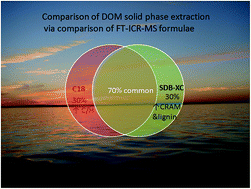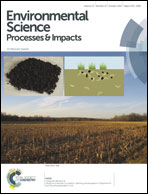Dissolved organic matter in Lake Superior: insights into the effects of extraction methods on chemical composition
Abstract
Dissolved organic matter (DOM) in aquatic systems plays many biogeochemical roles, acting as a sunscreen, a food source, a trace metal chelator, and a photosensitizer. The efficiency of DOM in these roles is, in part, a function of its composition, which is difficult to determine due to its heterogeneity and the difficulty in isolating representative portions for subsequent molecular level analyses. In this study, the performance of two major types of solid phase extraction (SPE) resins (C18 vs. polymeric SDVB) in disk format (C18 disk vs. SDB-XC disk) was studied using DOM from Lake Superior, the earth's largest lake by area. The performance of the two SPE disks and their influences on the molecular chemical composition of the extracted retentates were studied with UV-vis spectrometry and negative-ion electrospray Fourier transform ion cyclotron resonance mass spectrometry (ESI FT-ICR MS). We found that SDB-XC disks outperformed C18 disks in the isolation of DOM in terms of both higher recovery and less fractionation relative to the initial DOM composition. Extracts of the same samples obtained with the different resins shared 70% of molecular formulae. Compounds exclusive to the SDB-XC extractions exhibited similar compound distributions to those of the shared formulae but were enriched in N, P, and S and more aromatic. The C18 exclusive compounds had somewhat higher H/C ratios and contained a large proportion of compounds with oxygen and nitrogen (CHON). Cluster analysis and principle component analysis confirmed that sample location was the main driver of the composition of extracted samples but showed some fractionation of the samples based upon the type of resin.

- This article is part of the themed collection: Natural Organic Matter

 Please wait while we load your content...
Please wait while we load your content...